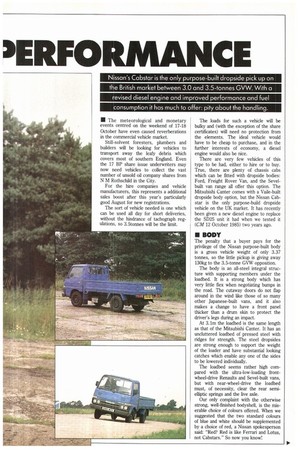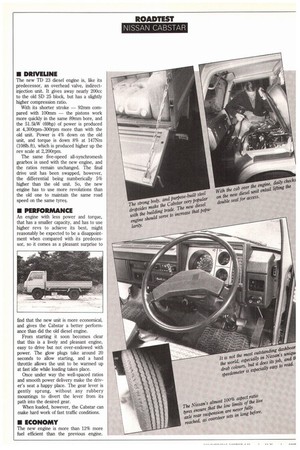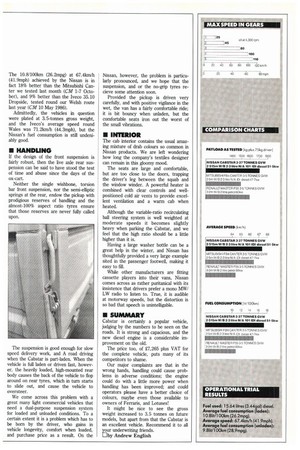;DERFORIVIANC
Page 61

Page 62

Page 63

If you've noticed an error in this article please click here to report it so we can fix it.
Nissan's Cabstar is the only purpose-built dropside pick up on the British market between 3.0 and 3.5-tonnes GVW. With a revised diesel engine and improved performance and fuel consumption it has much to offer: pity about the handling.
• The meteorological and monetary events centred on the weekend of 17-18 October have even caused reverberations in the commercial vehicle market.
Still-solvent foresters, plumbers and builders will be looking for vehicles to transport away the leafy debris which covers most of southern England. Even the 17 BP share issue underwriters may now need vehicles to collect the vast number of unsold oil company shares from N M Rothschild in the City.
For the hire companies and vehicle manufacturers, this represents a additional sales boost after this year's particularly good August for new registrations.
The sort of vehicle needed is one which can be used all day for short deliveries, without the hindrance of tachograph regulations, so 3.5tonnes will be the limit. The loads for such a vehicle will be bulky and (with the exception of the share certificates) will need no protection from the elements. The ideal vehicle would have to be cheap to purchase, and in the further interests of economy, a diesel engine would also be nice.
There are very few vehicles of this type to be had, either to hire or to buy. True, there are plenty of chassis cabs which can be fitted with dropside bodies: Ford, Freight Rover Van, and the Sevelbuilt van range all offer this option. The Mitsubishi Canter comes with a Vaile-built dropside body option, but the Nissan Cabstar is the only purpose-build dropside vehicle on the UK market. It has recently been given a new diesel engine to replace the SD25 unit it had when we tested it (CM 12 October 1985) two years ago.
• BODY
The penalty that a buyer pays for the privilege of the Nissan purpose-built body is a gross vehicle weight of only 3.37 tonnes, so the little pickup is giving away 130kg to the 3.5-tonne GVW opposition.
The body is an all-steel integral structure with supporting members under the loadbed. It is a strong body which has very little flex when negotiating bumps in the road. The cutaway doors do not flap around in the wind like those of so many other Japanese-built vans, and it also makes a change to have a front panel thicker than a drum skin to protect the driver's legs during an impact.
At 3.1m the loadbed is the same length as that of the Mitsubishi Canter. It has an uncluttered loadbed of pressed steel with ridges for strength. The steel dropsides are strong enough to support the weight of the loader and have substantial looking catches which enable any one of the sides to be lowered individually.
The loadbed seems rather high compared with the ultra-low-loading frontwheel-drive Renaults and Sevel-built vans, but with rear-wheel-drive the loadbed must, of necessity, clear the rear semielliptic springs and the live axle.
Our only complaint with the otherwise strong, well-finished bodyshell, is the miserable choice of colours offered. When we suggested that the two standard colours of blue and white should be supplemented by a choice of red, a Nissan spokesperson said: "Red? Red is like Ferrari and Lotus, not Cabstars." So now you know!
• DRIVEUNE
The new TD 23 diesel engine is, like its predecessor, an overhead valve, indirectinjection unit. It gives away nearly 200cc to the old SD 25 block, but has a slightly higher compression ratio.
With its shorter stroke — 92mm compared with 100mrn — the pistons work more quickly in the same 89mm bore, and the 51.5kW (69hp) of power is produced at 4,300rpm-300rpm more than with the old unit. Power is 4% down on the old unit, and torque is down 8% at 147Nm (1081b. ft), which is produced higher up the rev scale at 2,200rpm.
The same five-speed all-synchromesh gearbox is used with the new engine, and the ratios remain unchanged. The final drive unit has been swapped, however, the differential being nurnberically 5% higher than the old unit. So, the new engine has to use more revolutions than the old one to maintain the same road speed on the same tyres.
• PERFORMANCE
An engine with less power and torque, that has a smaller capacity, and has to use higher revs to achieve its best, might reasonably be expected to be a disappointment when compared with its predecessor, so it comes as a pleasant surprise to find that the new unit is more economical, and gives the Cabstar a better performance than did the old diesel engine.
From starting it soon becomes clear that this is a lively and pleasant engine, easy to drive but not over-endowed with power. The glow plugs take around 20 seconds to allow starting, and a hand throttle allows the unit to be warmed up at fast idle while loading takes place.
Once under way the well-spaced ratios and smooth power delivery make the driver's seat a happy place. The gear lever is gently sprung, without any rubbery mountings to divert the lever from its path into the desired gear.
When loaded, however, the Cabstar can make hard work of fast traffic conditions.
El ECONOMY
The new engine is more than 12% more fuel efficient than the previous engine. The 10.8/1001cm (26.2mpg) at 67.41cm/h (41.9nriph) achieved by the Nissan is in fact 18% better than the Mitsubishi Canter we tested last month (CM 1-7 October), and 9% better than the Iveco 35.10 Dropside, tested round our Welsh route last year (CM 10 May 1986).
Admittedly, the vehicles in question were plated at 3.5-tonnes gross weight, and the Iveco's average speed round Wales was 71.21unth (44.3mph), but the Nissan's fuel consumption is still undeniably good.
• HANDLING
If the design of the front suspension is fairly robust, then the live axle rear suspension can be said to have stood the test of time and abuse since the days of the ox-cart.
Neither the single wishbone, torsion bar front suspension, nor the semi-elliptic springs at the rear, endow the pickup with prodigious reserves of handling and the almost-100% aspect ratio tyres ensure that those reserves are never fully called upon.
The suspension is good enough for slow speed delivery work, and A road driving when the Cabstar is part-laden. When the vehicle is full laden or driven fast, however, the heavily loaded, high-mounted rear body causes the back of the vehicle to flop around on rear tyres, which in turn starts to slide out, and cause the vehicle to oversteer.
We come across this problem with a great many light commercial vehicles that need a dual-purpose suspension system for loaded and unloaded conditions. To a certain extent it is a problem which has to be horn by the driver, who gains in vehicle longevity, comfort when loaded, and purchase price as a result. On the Nissan, however, the problem is particularly pronounced, and we hope that the suspension, and or the no-grip tyres recieve some attention soon.
Provided the pickup is driven very carefully, and with positive vigilance in the wet, the van has a fairly comfortable ride; it is bit bouncy when unladen, but the comfortable seats iron out the worst of the small vibrations.
• INTERIOR
The cab interior contains the usual amazing mixture of drab colours so common in Nissan products. We are left wondering how long the company's textiles designer can remain in this gloomy mood.
The seats are large and comfortable, but are too close to the doors, trapping the driver's leg between the squab and the window winder. A powerful heater is combined with clear controls and wellpositioned cold air vents to provide excellent ventilation and a warm cab when heated.
Although the variable-ratio recirculating ball steering system is well weighted at moderate speeds it becomes slightly heavy when parking the Cabstar, and we feel that the high ratio should be a little higher than it is.
Having a large washer bottle can be a great help in the winter, and Nissan has thoughtfully provided a very large example sited in the passenger footwell, making it easy to fill.
While other manufacturers are fitting cassette players into their vans, Nissan comes across as rather puritanical with its insistence that drivers prefer a mono MW/ LW radio to listen to. True, it is audible at motorway speeds, but the distortion is so bad that speech is unintelligable.
• SUMMARY
Cabstar is certainly a popular vehicle, judging by the numbers to be seen on the roads. It is strong and capacious, and the new diesel engine is a considerable improvement on the old.
The price too, of 27,265 plus VAT for the complete vehicle, puts many of its competitors to shame.
Our major complaints are that in the wrong hands, handling could cause problems in adverse conditions; the engine could do with a little more power when handling has been improved; and could operators please have a better choice of colours, maybe even those available to owners of Ferraris, and Lotuses!
It might be nice to see the gross weight increased to 3.5 tonnes on future models, but apart from that the Cabstar is an excellent vehicle. Recommend it to all your underwriting friends.
L_Iby Andrew English








































































































